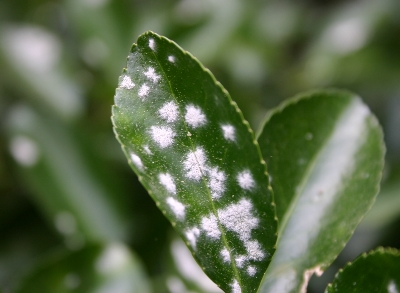Euonymus – Powdery Mildew

Q: There are powdery spots all over the leaves of my euonymus. I believe this is called powdery mildew. If so, what can I do about it?
A: The name of this disease exactly fits its description doesn’t it? Powdery mildew afflicts many plants: crape myrtle, rose, verbena, phlox and euonymus, to name a few.
The fungus usually attacks the leaves of a plant when nights are cool but daytime temperatures are warm. The disease is host-specific: the mildew on your euonymous will not infect a nearby rose or crape myrtle. If conditions are ripe, though, mildew strains that attack them may develop right alongside the one you see growing on your plant.
You could almost describe this fungus as a parasite because it sends “roots” into the leaf cells, where they absorb cell nutrients. Powdery mildew doesn’t want to kill your plant, because that would destroy its food source. It only is looking for a free meal, no matter how much it blemishes your plant.
Mildew spores are just about everywhere but you can blunt their attack by removing dead leaves from under deciduous hosts each fall. This is a good first step when faced with powdery mildew on dogwood, crape myrtle, phlox, verbena and rose.
Plants that can tolerate hot sun should be placed there, not in shade, since wind and dry leaves inhibit powdery mildew development. Selecting mildew resistant plants, such as ‘Cherokee Brave’ dogwood and ‘Miss Lingard’ phlox will also help thwart the disease.
Your euonymus won’t die from the disease but you may choose to protect new leaves with a garden fungicide (click for sources) labeled for use on ornamentals. There are both contact and systemic products available.
Given my druthers, I’d use products that contain propaconazole (Bonide Infuse) or myclobutanil (Spectracide Immunox).


















